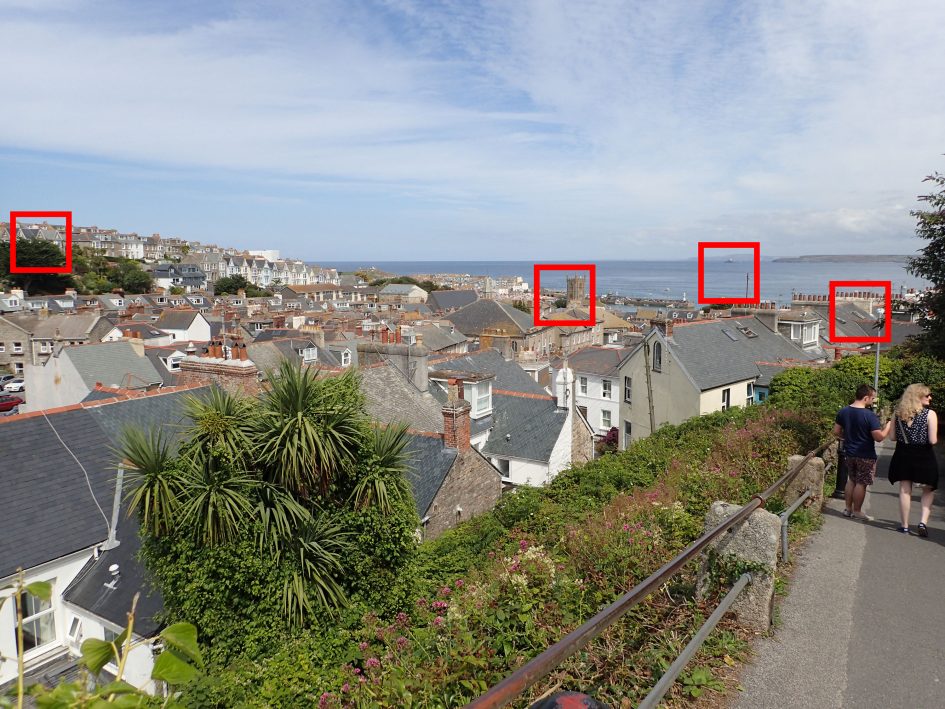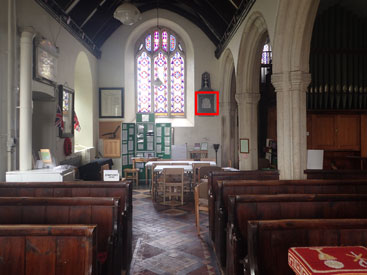Olympus TOUGH TG4 review
-
-
Written by Ken McMahon
Quality
Olympus TOUGH TG4 vs TOUGH TG-860 vs Nikon COOLPIX AW130 quality results
To compare real-life performance, I shot this scene with the Olympus Stylus TOUGH TG4, the Olympus Stylus TOUGH TG-860 and the Nikon COOLPIX AW130 within a few moments of each other, using their best quality JPEG settings and at their base sensitivity settings. For this test the cameras were mounted on a tripod and image stabilisation was disabled. The cameras were zoomed in to provide the same field of view, the ISO sensitivity was manually set to the lowest available setting and Program Auto mode was selected for the exposure. All other settings were left on the defaults.

At first glance, the crops from the Olympus TOUGH TG4 look pretty good. Generally you can see a fair amount of detail and the edges are nice and sharp. The first crop which is from the extreme left edge of the frame looks a little blurry, as does the final crop from close to the right edge. That’s something you’d expect to see on all but the most expensive lenses and it’s not so bad you’d notice other than at 100 percent viewing sizes. There are no other issues like colour fringing caused by chromatic aberration, or if there are, they’ve been dealt with by the camera firmware.
The two crops from closer to the middle of the frame are a little sharper and more detailed. Though you can’t make out the time on the church clock there’s plenty of fine detail in the roofs on the second crop and the lighthouse is a distinct white column (you can just about make out the lamp house) in the third.
The TOUGH TG4 crops compare very favourably with those from the TOUGH TG-860 and COOLPIX AW130. All three cameras have 16 Megapixel CMOS sensors, so the crop areas are the same with the same sized detail. Overall, the TOUGH TG4 crops look more punchy though, look at how much more detail there is in the foliage in the first TG4 crop compared to the TG-860 and AW-130.
The TOUGH TG-860 crops look comparatively noisy and some of the detail in the COOLPIX AW130 crops looks a little blocky. It’s possible the COOLPIX is applying a slightly higher level of compression to its images, the COOLPIX AW130 test image file was 7.5MB compared with 8MB for the TOUGH TG4 file.

Above left: Olympus TOUGH TG4 at 4.5mm (25mm equivalent) f8, 100 ISO. Above center: Olympus TOUGH TG-860 at 4.7mm (26mm equivalent) f4.3, 125 ISO. Above right: Nikon COOLPIX AW130 at 4.7mm (26mm equivalent) f4.1, 125 ISO.

Above left: Olympus TOUGH TG4 at 4.5mm (25mm equivalent) f8, 100 ISO. Above center: Olympus TOUGH TG-860 at 4.7mm (26mm equivalent) f4.3, 125 ISO. Above right: Nikon COOLPIX AW130 at 4.7mm (26mm equivalent) f4.1, 125 ISO.

Above left: Olympus TOUGH TG4 at 4.5mm (25mm equivalent) f8, 100 ISO. Above center: Olympus TOUGH TG-860 at 4.7mm (26mm equivalent) f4.3, 125 ISO. Above right: Nikon COOLPIX AW130 at 4.7mm (26mm equivalent) f4.1, 125 ISO.

Above left: Olympus TOUGH TG4 at 4.5mm (25mm equivalent) f8, 100 ISO. Above center: Olympus TOUGH TG-860 at 4.7mm (26mm equivalent) f4.3, 125 ISO. Above right: Nikon COOLPIX AW130 at 4.7mm (26mm equivalent) f4.1, 125 ISO.
Olympus TOUGH TG4 vs TOUGH TG-860 vs Nikon COOLPIX AW130 noise results
To compare noise levels under real-life conditions, I shot this scene with the Olympus Stylus TOUGH TG4, the Olympus Stylus TOUGH TG-860 and the Nikon COOLPIX AW130 within a few moments of each other at each of their ISO settings. All three cameras were set to their best quality JPEG modes and mounted on a tripod and stabilisation was disabled. Shadow Adjust was turned off on the TG4 and TG-860, but otherwise the cameras were left on their default settings.
The cameras were zoomed in to provide the same field of view, the ISO sensitivity was manually set to the lowest available setting and Program Auto mode was selected for the exposure.

At 100 ISO the TOUGH TG4 selected an exposure of 1/8 at f2.3. Set to its base 125 ISO sensitivity setting the TOUGH TG-860 metered 1/4 at f4.7 and also at 125 ISO the COOLPIX AW130 selected 1/6 at f4.2. The crops below are selected from the area marked in red above.
The 100 ISO crop from the Olympus TOUGH TG4 is hard to fault. There’s very little evidence of noise and a good level of detail with the text on the memorial panel clearly legible. There’s quite a big difference between the 100 and 200 ISO crops, though, and though the latter doesn’t look too grainy, there’s a visible clumpiness and some smearing. There’s another quite large deterioration from 200 to 400 ISO which essentially is more of the same. At 800 ISO, as you’d expect, things get worse but this time in addition to the clumping of detail there are now very visible noise textures making the text illegible. The 1600 ISO crop looks quite nasty at 100 percent, but it’s always surprising how shots at high ISO settings on compacts can look perfectly passable at smaller sizes and the TOUGH TG4 is no exception. That said, the 3200 and 6400 ISO settings are best held in reserve for those must have whatever the quality shots.
Both the TOUGH TG-860 and COOLPIX AW130 start at a slightly higher base sensitivity of 125 ISO and both display more visible noise at this setting than the TOUGH TG4. The TOUGH TG-860 crop looks grainier and the COOLPIX AW130 crop looks clumpier. At the higher ISO sensitivity settings I don’t think there’s a great deal of difference between the three, but the TOUGH TG4’s advantage at its base ISO sensitivity setting is a big plus, particularly when allied with it’s bright f2.0 lens, which lest we forget allows it to shoot at lower ISOs than its rivals under the same lighting conditions.
Shooting at the wide angle setting in the same lighting conditions with the same shutter speed, you could set 100 ISO on the TOUGH TG-4 where you’d need 200 ISO on the AW130 or 320 ISO on the TG-860 if all were using their maximum apertures. The other thing to bear in mind is that the TG-860 and AW130 set the aperture automatically in this case to f4.7 and f4.2 respectively, whereas the TOUGH TG4’s Aperture priority mode gives you the opportunity to open it all the way up to f2.

Above left: Olympus TOUGH TG-4 at 100 ISO. Above center: Olympus TOUGH TG-860 100 ISO not available. Above right: Nikon COOLPIX AW130 100 ISO not available

Above left: Olympus TOUGH TG-4 at 200 ISO. Above center: Olympus TOUGH TG-860 at 200 ISO Above right: Nikon COOLPIX AW130 at 200 ISO.

Above left: Olympus TOUGH TG-4 at 400 ISO. Above center: Olympus TOUGH TG-860 at 400 ISO Above right: Nikon COOLPIX AW130 at 400 ISO.

Above left: Olympus TOUGH TG-4 at 800 ISO. Above center: Olympus TOUGH TG-860 at 800 ISO Above right: Nikon COOLPIX AW130 at 800 ISO.

Above left: Olympus TOUGH TG-4 at 1600 ISO. Above center: Olympus TOUGH TG-860 at 1600 ISO Above right: Nikon COOLPIX AW130 at 1600 ISO.

Above left: Olympus TOUGH TG-4 at 3200 ISO. Above center: Olympus TOUGH TG-860 at 3200 ISO Above right: Nikon COOLPIX AW130 at 3200 ISO.

Above left: Olympus TOUGH TG-4 at 6400 ISO. Above center: Olympus TOUGH TG-860 at 6400 ISO Above right: Nikon COOLPIX AW130 at 6400 ISO.




